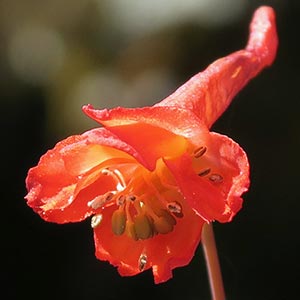Delphinium nudicaule
Delphinium menziesii
canyon delphinium, canyon larkspur, orange larkspur, red larkspur, red or orange larkspur, scarlet larkspur
Menzies' larkspur
(15-)20-50(-125) cm;
base reddish, glabrous.
(10-)35-70(-85) cm;
base often reddish, puberulent.
blade round to pentagonal, 2-6 × 3-10 cm; ultimate lobes 3-12, width 5-40 mm (basal), 2-20 mm (cauline).
blade round, 1.5-5 × 3-9 cm, puberulent; ultimate lobes 5-18, width 2-15 mm (basal), 1-10 mm (cauline), widest at middle or in proximal 1/2.
5-20(-69)-flowered;
pedicel (1.5-)2-6(-8) cm, glabrous to glandular-pubescent;
bracteoles 14-20(-30) mm from flowers, green to red, linear, 2-4(-9) mm, glabrous to puberulent.
3-15(-43)-flowered;
pedicel 1.5-4(-7) cm, (glandular) puberulent;
bracteoles 8-10(-24) mm from flowers, green to blue, linear, 4-6(-9) mm, puberulent.
sepals scarlet to reddish orange, rarely dull yellow, glabrous, lateral sepals forward-pointing to form pseudotube, (6-)8-13(-16) × 3-6 mm, spurs straight, slightly ascending, (12-)18-27(-34) mm;
lower petal blades elevated, exposing stamens, 2-3 mm, clefts 0.5-1 mm;
hairs sparse, evenly dispersed, yellow.
sepals bluish purple or yellowish, often partly fading upon drying, puberulent, lateral sepals spreading, (11-)13-20 × 5-11 mm, spurs straight, ascending less than 30° above horizontal, 11-17 mm;
lower petal blades ± covering stamens, 8-12 mm, clefts 0.2-2.5 mm;
hairs sparse, centered, mostly near junction of blade and claw above base of cleft, white or blue.
13-26 mm, 3.5-4.5 times longer than wide, glabrous.
11-17 mm, 3.5-4 times longer than wide, puberulent.
unwinged or sometimes slightly wing-margined;
seed coat cells with surfaces smooth.
wing-margined;
seed coat cell surfaces smooth, without swollen blunt hair.
= 16.
Delphinium nudicaule
Delphinium menziesii
Delphinium nudicaule hybridizes with most other taxa of Delphinium that it encounters. Apparent hybrids involving D. nudicaule, and seen by the author (either afield or as specimens), include D. andersonii, D. antoninum, D. decorum, D. luteum, D. nuttallianum, D. patens, and D. trolliifolium. In addition, garden-grown plants have been hybridized with D. cardinale, D. elatum, D. menziesii, D. parishii, D. penardii, D. tatsienense Franchet, D. triste Fischer ex de Candolle, and D. uliginosum; D. nudicaule does not naturally occur with these species. Delphinium nudicaule is one of the earliest larkspurs to flower in any given locality. Douglas's type collection of D. nudicaule represents plants (synonyms D. sarcophyllum Hooker & Arnott and D. peltatum Hooker, an invalid name) grown under very moist conditions, probably quite near the ocean. The type specimen of D. armeniacum A. Heller represents plants grown under unusually dry conditions.
The Mendocino Indians consider Delphinium nudicaule a narcotic (D. E. Moerman 1986).
(Discussion copyrighted by Flora of North America; reprinted with permission.)
Subspecies 2 (2 in the flora).
Although Delphinium menziesii has often been confused with D. nuttallii, it may be distinguished by its consistently larger flowers and usually fewer flowers per plant. Interestingly, each species produces both blue-purple and yellowish flower colors in separate populations.
The Chehalis consider Delphinium menziesii poisonous, but they also apply it to sores. The women of the Thompson Indians use it as a love charm (D. E. Moerman 1986, subspecies not indicated).
(Discussion copyrighted by Flora of North America; reprinted with permission.)
1. Sepals blue to purple. | subsp. menziesii |
1. Sepals yellowish to white. | subsp. pallidum |


